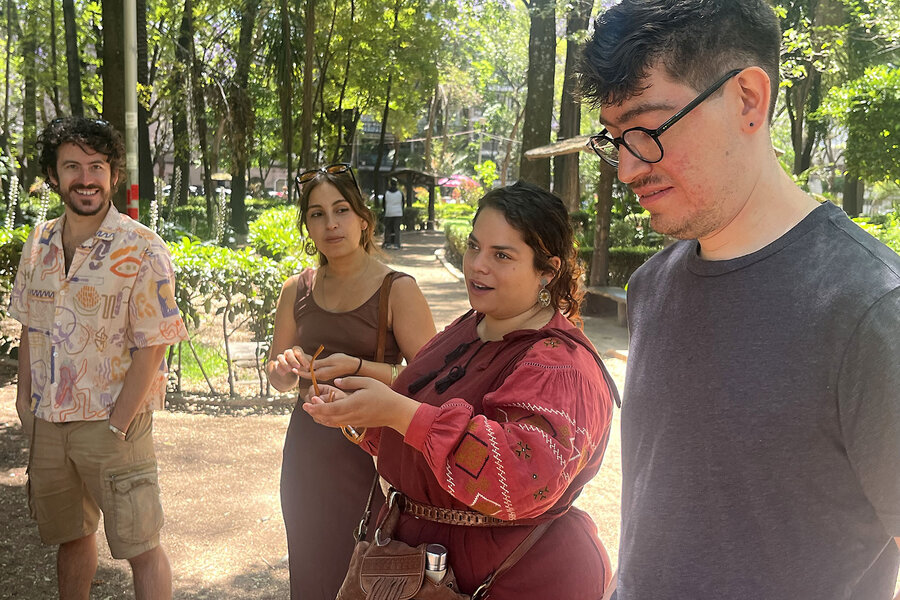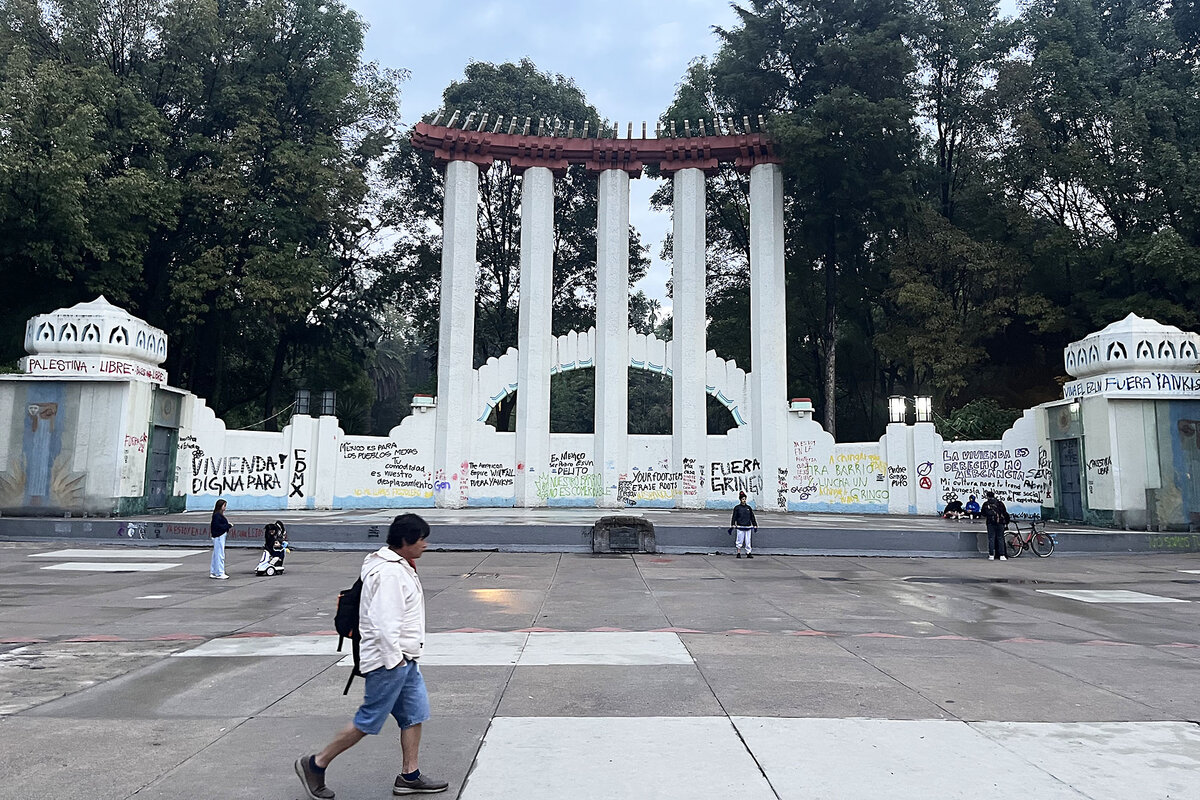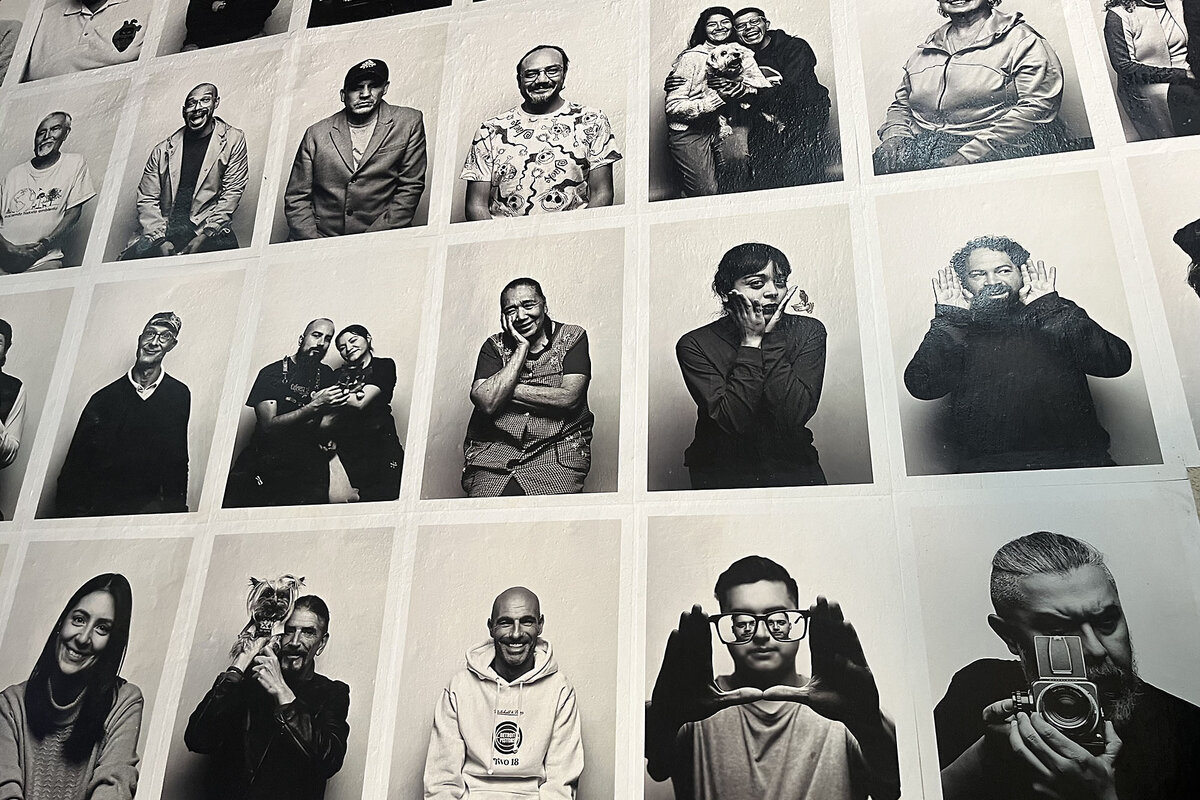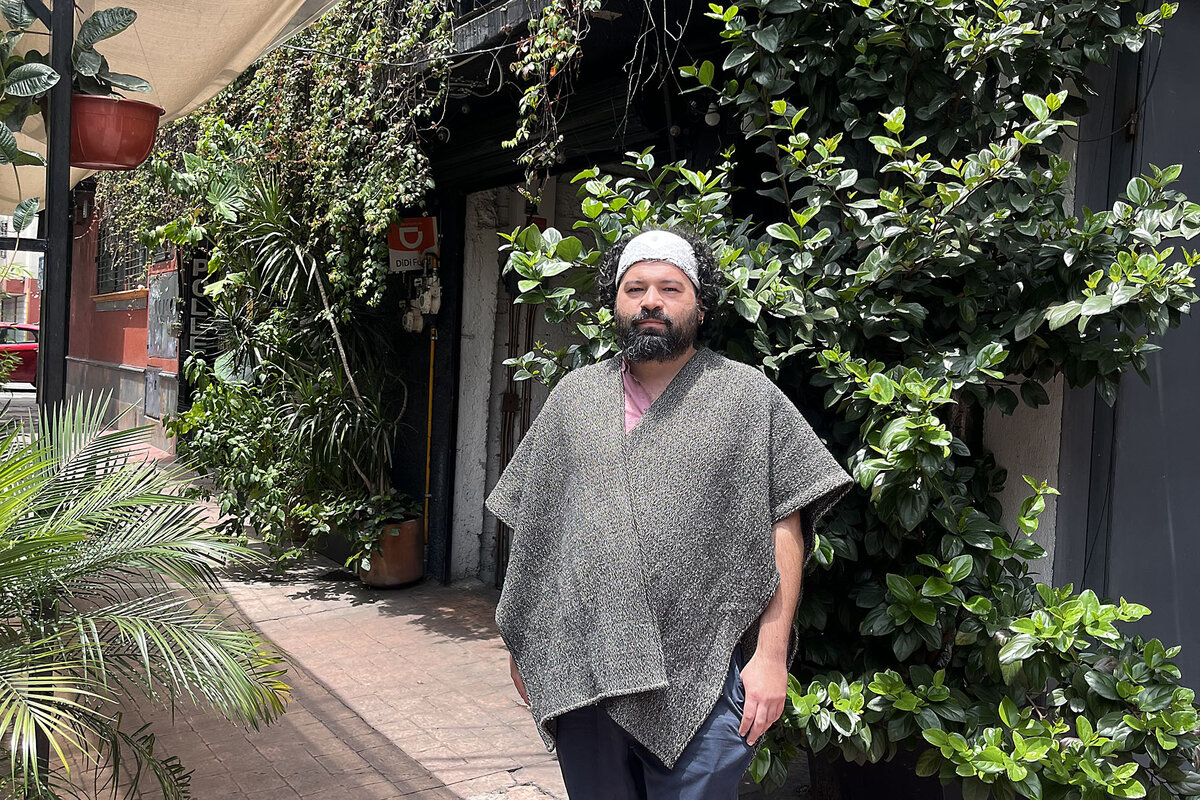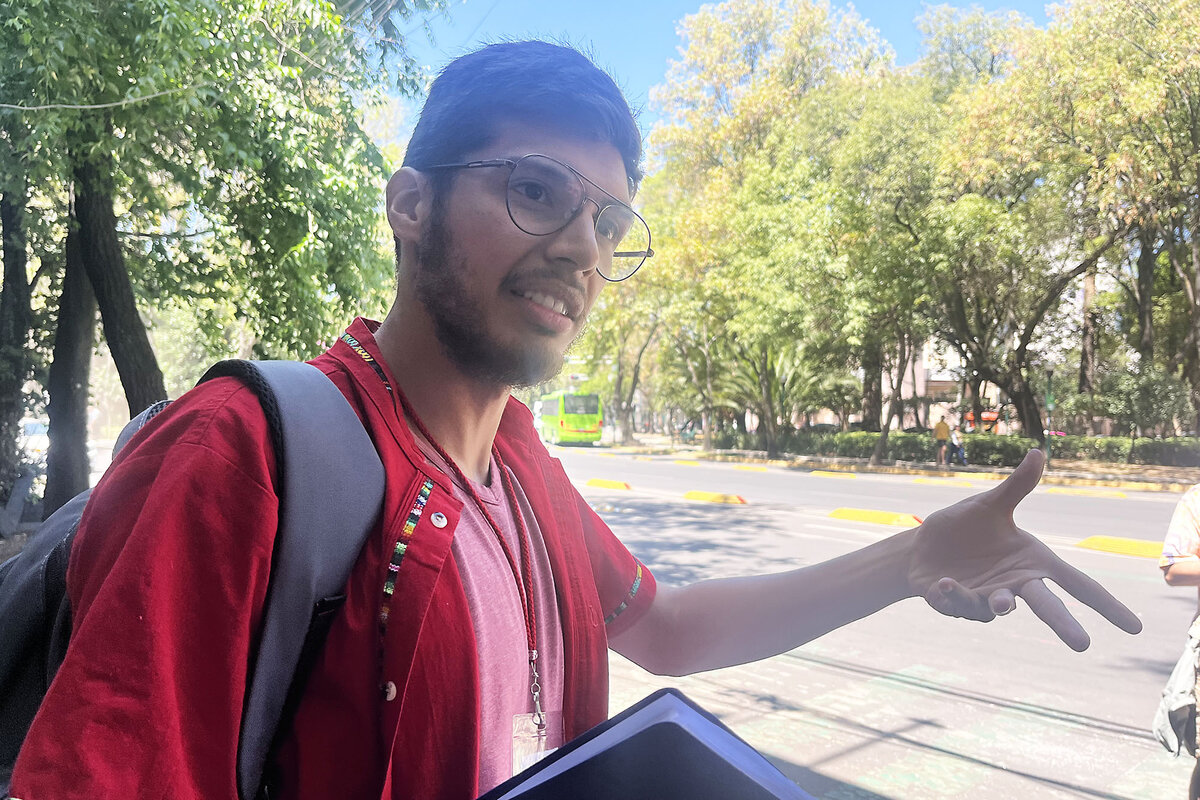As foreign money gentrifies Mexico’s capital, locals ask: Whose city is it?
Loading...
| Mexico City
On a Saturday morning in April, a small group of people obstructs a bustling sidewalk. Toting backpacks and clad in sensible walking shoes, they look every bit like sightseers as they listen to their guide, Carlos Eduardo Graterol Rosales, explain the story behind the name of this popular neighborhood, Condesa.
But in a city that has seen a controversial influx of wealthy foreigners over the past five years, this isn’t your average walking tour.
Mr. Graterol is Venezuelan, and the Native Encounters tour he leads is about people like him – the migrants whose experiences have shaped this megacity, past and present.
Why We Wrote This
Mexico’s capital is wrestling with a complex question familiar to many of the world’s metropolises.
Outsiders “form a part of the story of this country, even if we’re not from here,” he says, standing beside a monument dedicated to a Mexican president who offered refuge to Spaniards during their country's civil war.
This tour is part of a growing movement in Mexico City to spark conversations – and action – around the city’s rapid transformation. With Mexico City acting as a World Cup host next year, there is an increasingly urgent worry about gentrification and the displacement it often brings in its wake. And as local frustration with inflation, evictions, and cultural shifts swells, many here are asking: Whom does the city belong to?
The ‘whitewashed’ city
On a recent evening in the lush neighborhood of Condesa, children kick soccer balls and adults exercise on an esplanade in a sprawling 1920s-era park. The tranquil scene is at odds with fresh, angry graffiti scrawled on the amphitheater walls in Spanish and English. “Get out Yankees,” one warns. “Dignified housing for all,” demands another.
The graffiti appeared in early July, after a protest against the rapid changes the neighborhood is undergoing. That gathering was initially conceived by activists and residents as a kind of open mic for people concerned about the area’s gentrification. The date chosen, July 4, was a deliberate nod to the role of Americans in Mexico City’s changes. But the event unexpectedly evolved into a march, which turned violent when masked participants arrived, some brandishing knives and vandalizing storefronts.
The demonstration and the graffiti came in response to what some here call the “whitewashing” of Mexico City – a recent influx of Americans and Europeans that many locals believe has fundamentally altered the character of the city. These new residents and visitors arrived in droves during the pandemic, made up largely of so-called digital nomads newly untethered by their ability to work remotely. Many were drawn to Mexico City’s relatively cheap prices, good weather, convenient time zone, and generous visas. Mexico also never shut its borders during the pandemic, encouraging tourism.
From the start, the relationship was fraught. Entire buildings in photogenic neighborhoods like Condesa have been turned over to short-term rentals, jacking up fees and expelling longtime residents. Diners are regularly greeted in English and given sometimes questionably translated menus, and exercise instructors frequently ditch Spanish at the arrival of even just one foreigner in their class. Videos of foreigners disrespecting local customs are commonplace on social media.
This sense of being pushed out and replaced is what led many to join the July demonstration, says Tizoc Sánchez, a resident of a nearby neighborhood who was there that day.
Mr. Sánchez, who runs an Instagram account about his neighborhood, says it’s the speed of change that has him most concerned. When his favorite mom-and-pop tortilleria disappeared from its storefront seemingly overnight last year, he wondered what could be done to keep his area from meeting the same fate as Condesa.
“Above all, I want to see certain community rights and the social fabric protected,” he says, sitting at an outdoor table at a café decorated with a wallpaper of photos of neighbors and regular customers. “This is what makes our neighborhood a neighborhood: We feel connected.”
Mr. Sánchez moved to Mexico City from Puebla state a decade ago. The neighborhood Instagram page he runs is an ode to his adoptive home, showcasing businesses in the area and forgotten local histories. He says he’d like to someday organize neighborhood tours to bring together new and old residents, regardless of their place of origin.
“The issue of gentrification isn’t a question of nationality,” says Luis Alberto Salinas Arreortua, an expert on housing policy at the National Autonomous University of Mexico. Gentrification “is a more systemic, structural issue” than the arrival of migrants, he says.
Dr. Salinas’ dissertation focused on the transformation of residential properties into commercial spaces in Condesa between 2010 and 2013; he argues that this kind of change has been central to the neighborhood’s steeply rising housing costs.
Notably, that problem predates the influx of foreigners. Housing costs in Mexico City jumped 44% between 2016 and 2020, according to an analysis by Viri Ríos, a Mexican social scientist. They rose 25% between 2020 and 2024, but that was actually slower than in almost any other part of Mexico. In an op-ed in Spanish newspaper El País last year, Dr. Ríos argued that blaming foreigners for rising costs of living was both inaccurate and a distraction from the real causes, such as a shortage of housing stock and poor policies .
For example, in 2022, when now-President Claudia Sheinbaum was mayor of Mexico City, she signed an agreement with the United Nations cultural organization UNESCO and Airbnb to promote remote work and boost tourism. It encouraged hosts on the platform to offer discounts for long-term rentals. Today, there are upwards of 26,000 on the site, and Airbnb is frequently blamed for diminishing long-term rental property offerings and pushing up prices.
Even if that is the case, it doesn’t mean outsiders are blameless, says U.S. transplant Rachel Finklestein. She is part of a volunteer group called Gringo Tax, which emerged from neighborhood mutual aid efforts during the pandemic, delivering groceries and supporting local informal workers.
Gringo Tax encourages those with more resources – such as outsiders coming for a few months of remote work, economically comfortable locals, and foreigners who have adopted the city as their own – to pay into a community aid fund. Others in the neighborhood can then apply for assistance covering the cost of medicine or groceries.
Although the effort is still in its infancy, the idea is for neighbors to find “alternative ways of supporting one another,” says Ms. Finklestein.
Such work is also an attempt to maintain economic diversity in rapidly gentrifying neighborhoods. That is also what many at the July protest were seeking.
The Mexico City Anti-Gentrification Front, one of the protest organizers, said in a statement on social media that working-class and young Mexicans “can’t afford to live here” anymore. Their demands on the government include stricter rent controls, laws making evictions more difficult, mandates giving locals a bigger say in development projects in their neighborhoods, and prioritizing locals over foreigners in the rental market.
Sharing space
Back on the Native Encounters tour, Mr. Graterol is sharing his own migration story. He came to Mexico to study architecture, and then realized he couldn’t return home to Caracas because of the political, humanitarian, and economic crises unfolding there. So he stayed, fell in love with theater, and became an actor – as well as a Mexican citizen.
“Art is what motivates me to live,” he says in front of a small, storefront theater in Condesa. “What we as individuals love in many ways motivates where we go and where we live.” He asks the group what the differences are between asylum-seekers, refugees, and migrants, sparking a discussion. Then Mr. Graterol tells everyone to pair off as they walk to their next stop, and discuss how they ended up in Mexico City.
The tour was conceptualized by Spanish transplant Ignacio Ahijado Aparicio, a trained mediator who wanted to get visitors thinking about “mobility, how you develop roots, and the legitimacy of being a local, even if it’s not your native place.”
“What’s at risk is the cohesion of this city,” he says. “It’s a bit of what’s happening in the U.S. – blaming everything on a group because they don’t ‘belong.’”
Mr. Ahijado acknowledges that a single walk “isn’t going to change much." But its power lies in being an initiator – of conversation, empathy, and understanding.
On the esplanade of a busy park in Condesa, Mr. Graterol asks the group to tell him what they see.
They note the presence of vendors hawking freshly cut fruit, people boxing, children clutching colorful balloons, and couples dancing bachata.
Samuel Ramos, a Mexican who now lives in Canada, chimes in. “Everyone is here,” he says, “sharing this space.”



